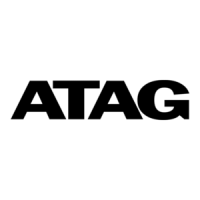43 | P a g e
Cause the return water temperature to rise. The sensor measures T2 – T1 > 35K (with burner on).
1P1, 1P2, 1P3, 101, 103, 104, 105, 106, 107 Fault codes.
1. Check the last 10 faults in the technical area for other pump or flow related faults to aid in diagnosis.
2. Check the system for an external heat source such as solar which may affect the return temperature.
3. Confirm flow and return temperatures, pump PWM and pump flow rate using the customer info menu.
4. Check T1 and T2 resistances in line with temperatures from flow and return temperatures found on page 67.
• Take resistances at the connector located on the bottom left of the PCB next to resistor RL5, pins
1&2. This checks the wiring harness continuity and connectors at same time.
• Check wiring connectors are not loose or corroded.
• Disconnect the connector from PCB to ensure no additional resistances are given through the PCB.
• If readings incorrect, take resistance reading direct from sensor & replace sensor or wiring harness
as required.
• Note sensors may need cleaning and not always replaced.
5. Check the pump speed is correct via parameters 2.4.5 & 2.4.6, adjust if required.
6. Ensure all air is vented out of the boiler and system.
7. On combi’s, the diverter valve operation may be faulty, check as follows:
• Safely isolate boiler from electrics.
• Remove the motor from the three-way valve and see if the cartridge moves up and down.
• If this doesn't move smoothly and seems to be sticking, replace the cartridge.
If the pump Flow Control is switched off (this can be checked in parameter 2.9.2) follow the following additional
checks.
Turn on flow control and use the customer information menu to give you data on the flow rate and PWM signals to
assist in fault finding. Using flow control may also give different fault codes which may be useful. If the flow control
does not aid fault finding, set the parameter back to as found & use the guidance below.
1. Check system pipework configuration correct.
2. Ensure all valves on the system and boiler are open.
3. Ensure all air is vented out of the boiler and system.
4. Check system pipework and filters for any blockages or restrictions.
5. Check all installation components are functioning correctly (mixing pumps and 2-way valves, etc.).
6. In the case of a combi, check the plate heat exchanger is not blocked.
7. Check for Voltage at the pump. You can force the pump 'on' via 2 methods:
• Preferred method and safest by using manual settings in parameter menu 2. Set parameter
2.6.0 to 1 = Manual mode On, and 2.6.1 to 1 pump control 'On'. Please note change 2.6.0 to 0
manual mode 'off' after this test.
or
• By removing PWM cable to allow 230v cable to power pump at full speed.
• If pump does not run via above tests check pins on pump not bent – straighten to fix and check
continuity across wiring harness. If all ok and no voltage going to pump, then PCB fault.
• If voltage to pump and all other checks are ok, replace pump.
8. If all the above checks are ok, PCB may be at fault.

